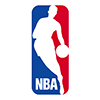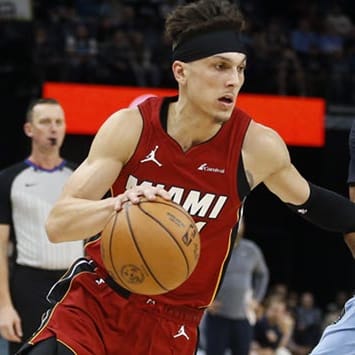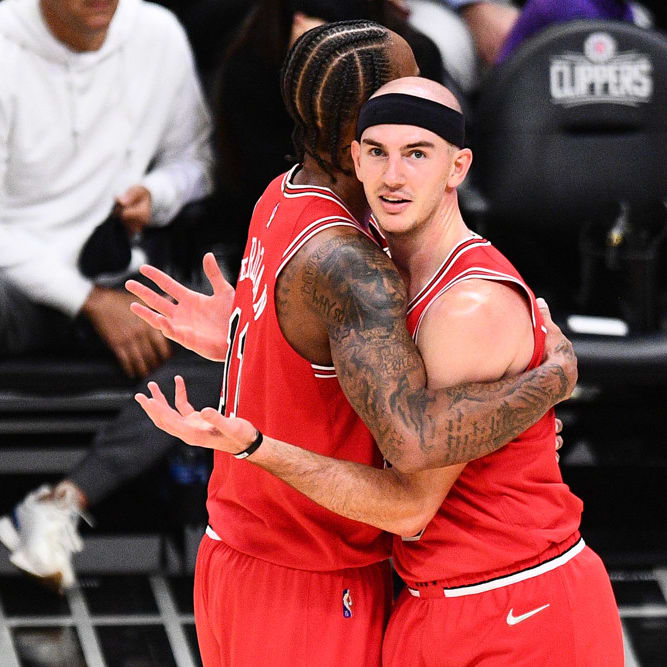This article is part of our NBA Draft series.
The vast majority of the discussion leading up to the 2017 NBA Draft has centered on the lottery -- and rightfully so. On the heels of a 2016 draft that, at least in the early returns, has been massively underwhelming, the 2017 edition is shaping up to be among the deepest and most talent-rich in recent memory.
It's a draft in which the player who ultimately goes fourth or fifth overall would rightfully challenge for the No. 1 spot in most other years. That also means players selected later in the first round would likely have gone a few spots higher in past drafts, so plenty of lottery-level talent will be available beyond the first 14 picks.
Below is a look at several players to keep an eye on as June's draft approaches. Most are currently projected to go in the latter half of in Round 1, but it wouldn't be a surprise if a few of these prospects force their way into the lottery conversation over the next three-plus months.
 Bam Adebayo (F)
Bam Adebayo (F)
Adebayo could certainly end up in the back-end of the lottery by the time mid-June rolls around, but he hasn't been quite the dominant interior force many projected he'd be at the college level, at least not on a consistent enough basis. A freak athlete who's drawn justifiable comparisons to Shawn Kemp, Adebayo is a threat to dunk over, around and through defenders any time he's in the restricted area. He's shooting nearly 62 percent from the floor, but a major reason for that is he rarely touches the ball outside the paint, and he hasn't displayed the type of touch that would forecast a future as a stretchy big man down the road.On athleticism and upside alone, Adebayo will easily be a first-round selection, but he'll need to improve his feel for the game at the next level in order to develop into more than a one-dimensional rim-runner on the offensive end.
 Ivan Rabb (F)
Ivan Rabb (F)
Firmly considered a lottery pick heading into the 2016 draft, Rabb's surprising decision to return to Cal for his sophomore season will likely cost him 5-10 slots in what's a significantly more-loaded 2017 draft. Still, like Adebayo, Rabb could fairly easily sneak his way into the end of the lottery.Currently projected in the 15-25 range, Rabb has put together a strong sophomore season, putting up 16 double-doubles and averaging 14.3 points, 10.6 rebounds and 1.1 blocks. From an efficiency standpoint, Rabb has regressed as a shooter, but he improved his ability to get to the free throw line and is still converted more than 50 percent of his field goals. At this point in his development, Rabb is far from a floor-spacer, but he looked just comfortable enough from beyond the arc to add credence to the notion that he could be a Chris Bosh-like inside-out threat down the road.
 Luke Kennard (G)
Luke Kennard (G)
If someone showed you a photo of Kennard and asked: Which high-major team does he lead in scoring? there would be only one answer.With apologies to Wisconsin and Notre Dame, Kennard meets all of the key criteria that make up a prototypical Duke star: He's white, he's fiery, and he can shoot. Few players have done more to improve their stock more than Kennard has this season. That he's leading the ACC in scoring (20.1 per game) isn't all that shocking -- Kennard was a five-star recruit and averaged nearly 12 points per game as a freshman -- but the efficiency with which he's doing it has propelled him firmly into the first round, should he opt to declare. The 6-6 lefty is shooting 50.4 percent from the floor and 45.0 percent from three on 5.5 attempts per game, but he's more than just a spot-up threat.
While he's probably a better athlete than he's given credit for, Kennard relies more on his hesitation and craftiness -- he'd be a unanimous First-Team All-Pump Fake selection -- to clear space and make plays in the halfcourt. Coach K doesn't often ask Kennard to be the primary initiator, but his 2.5 assists per game are good for second on the team.
When it comes to discussing Kennard's NBA future, you'll hear the usual white guy tropes: Three-point specialist, limited upside, a Kyle Korver-type. They're not necessarily all that inaccurate, though Kennard has the skill set offensively to be more than a three-point gunner at the pro level. While his collegiate numbers compare favorably to those of Klay Thompson in his final two years at Washington State, Kennard developing into a multi-time All-Star and arguably the second-greatest three-point shooter of all-time seems like a longshot. More realistic would be Kennard carving out a long career as a savvy, swing 2/3 in the mold of a Mike Miller.
 Caleb Swanigan (F)
Caleb Swanigan (F)
Another prospect who nearly declared for the 2016 draft, Swanigan came back to Purdue and put together one of the most dominant seasons in recent Big Ten history. On the short list of National Player of the Year candidates, Swanigan forward leads the country with 25 double-doubles (and counting), including four 20/20 games. The Boilermakers' offense runs through Swanigan, but he's not a black hole offensively, and his decision-making and shot selection have steadily improved over the last two seasons.As a sophomore, Swanigan is shooting 54 percent from the floor and 45 percent from three, while converting 79 percent of his 6.2 free throw attempts per game. Swanigan makes his living on the glass and in the paint, but his improved ability to stretch the floor -- 29% 3PT as a freshman -- is what will endear him to NBA scouts who question if his overwhelming physicality and rugged style will translate to the pro level.
At the Combine last May, Swanigan measured in at 6'8.5" in shoes, slightly undersized for an NBA power forward. And while he's a good athlete, Swanigan's 29-inch max vertical was the fourth-worst among all players measured. Working in his favor, though, is a massive, 7'3.5" wingspan, the fourth-longest at the Combine.
The general feeling is that Swanigan will be a fine rotational player, and had he come along 10 years earlier, he likely would have been a top-10 pick for some of the same reasons Sean May, bless his heart, went 13th to the then-Bobcats in 2005. In the current NBA, however, Swanigan's projected ceiling is relatively low, which probably relegates him to the latter half of the first round. Still, it's not difficult to imagine a team in early-20s talking themselves into Swanigan as a more-physical version of Patrick Patterson with Zach Randolph-like upside if everything breaks right.
 Justin Jackson (G)
Justin Jackson (G)
This time last year, Jackson was on the fence about his future. He could have been a second-round pick in 2016, but the decision to return to Chapel Hill for his junior season turned out to be the right one. The newly minted ACC Player of the Year has refined his game, going from a streaky three-point shooter to one of the top deep threats in the nation.Jackson's three-point accuracy is up nearly 10 percentage points, and he's more than doubled his attempts to 6.9 per game. With prototypical size (6'8", 6'11" wingspan) and athleticism for the shooting guard position, Jackson has the makings of a mid-to-late first-round selection. Leading the Tar Heels on a deep Tournament run could solidify his spot in the top-25.
 Jawun Evans (PG)
Jawun Evans (PG)
Unfortunately for Evans, if he declares he'll be a part of one of the most talented point guard classes in recent memory. As many as five of the top lottery 10 picks could be point guards, but whichever team grabs Evans later in the night could end up with the steal of the draft.It's a lazy analytical cliche, but Evans just looks like an NBA point guard in how he confidently quarterbacks the nation's top offense in terms of adjusted efficiency. The comparisons to Chris Paul are a bit much, but they're not far off. Spend some time watching Evans weave around screens, change speeds, and use dribble/head fakes to keep defenders on his hip, and it's clear who he models his game after.
Finding glaring holes in Evans' game is difficult. He's excellent at establishing tempo and pushing the ball in transition, equally comfortable pulling up off the dribble as he is getting all the way to the rim. Passing is his strongest suit -- Evans leads the Big 12 in assists and ranks third in the nation in assist rate -- but he still averages 18.7 points (second in Big 12), while knocking down 37 percent of his three-point tries.
At 6'1", Evans rebounds at a solid clip for his size -- 4.4 per game as a freshman, 3.3 this season -- and his 1.9 steals are good for fourth in the conference. Add two or three inches to Evans' frame and he'd be a near-lock for the lottery.
 Donavan Mitchell (G)
Donavan Mitchell (G)
With his top two players from last season, Damion Lee and Trey Lewis, lost to graduation, Rick Pitino turned to Mitchell to lead Louisville back to the Tournament following a self-imposed postseason ban. Somewhat of an unknown, nationally, after modest contributions -- 7.4pts, 3.4reb, 1.7ast, 25% 3PT -- as a freshman, Mitchell has grown into one of the best players in the nation's best conference, averaging 15.9 points, 4.7 rebounds, 2.6 assists and shooting 37 percent from three (6.6 3PA/game) en route to First-Team All-ACC honors.Like many of Pitino's former stars, Mitchell is a slashing shooting guard in a point guard's body. His 6'3" frame isn't ideal for an NBA two, but he's a explosive athlete whose emphatic dunks are what initially endeared him to the Cardinals' fan base. That athleticism, coupled with his drastic improvement as a long-range shooter, might be enough to position Mitchell somewhere in the final-third of Round 1. According to DraftExpress, Mitchell is the draft's 26th-best prospect, assuming he declares.
 John Collins (F)
John Collins (F)
This draft's version of Marquese Chriss, Collins is a big-time athlete who's steadily climbed up draft boards over the last few months. He was under-recruited out of high school, and the 6'10" sophomore has made massive strides under head coach Danny Manning. By mid-June, it wouldn't be much of a surprise if he works his way into the discussion at picks 8-14. With averages of 19.1 points and 9.8 rebounds per game this season, Collins quietly became the first Demon Deacon since Chris Paul to be named First-Team All-Conference, garnering the ACC's Most Improved Player award along the way. Collins, who leads the nation in KenPom offensive rating, was arguably the most consistent forward in the country, scoring at least 12 points in 29 of 31 games. He also racked up 16 double-doubles and reached the 20-point mark in 12 straight games from Jan. 18 to Mar. 1.
If there's a concern, it's that at this point in his development Collins is someone one-dimensional on offense, preferring to operate one-on-one in the deep post. That said, he's shown the ability to do more than bully his way to the rim and has improved as a mid-range threat out of the pick-and-pop. Collins' range doesn't extend beyond 15 feet, however -- one career three-point attempt -- and he has just 14 total assists on the season. Still, given his touch around the rim (62% FG) and relatively smooth stroke for a big man (74%, 6.4 FTA/G), there's reason to believe the foundation is in place for Collins to eventually extend his range.
On the other end, Collins has all of the physical tools to be an effective inside-out defender, but his footwork could still use refining. He's a quick leaper and works hard on the glass, two skills that should translate well to the NBA level. At 6'10", Collins has prototypical size for an NBA four, and his body should continue to fill out over the next year or two. He's already reportedly added 20 pounds to his frame and increased his vertical leap by five inches since first stepping foot on campus in 2015.
Also working in Collins' favor is his age. He won't turn 20 until late-September, and despite his sophomore status, Collins is actually several months younger than Josh Jackson and Lauri Markkanen, and less than a month older than Texas A&M freshman Robert Williams.
 Tyler Lydon (F)
Tyler Lydon (F)
After a strong freshman year, Lydon got off to a bit of a slow start before reeling off several strong performances during ACC play. Highlighted by a 29-point (12-13 FG), 9-rebound effort in a mid-December matchup with Georgetown, Lydon showed scouts why he's considered one of the best all-around forwards in the country. While he's sometimes too passive on a Syracuse team that relies heavily on his scoring, Lydon has forced his way into the discussion in the 18-25 range of the first round.At 6'9" with above-average athleticism, Lydon's best skill is his ability to rise and fire over just about anyone, and he's shooting the three at a 40-plus percent clip for the second straight season. He can also operate off the dribble, but that's likely not something he'll be asked to do as often at the pro level. Given his ability to both shoot from the outside and put the ball on the floor, Sam Dekker might be the most obvious, recent comparison, but Lydon is bigger and is a better rebounder than Dekker ever was at Wisconsin.
 Terrance Ferguson, G/F, International
Terrance Ferguson, G/F, International
Following in the footsteps of Emmanuel Mudiay and Brandon Jennings, Ferguson, a McDonald's All-American and one of the top players in the 2016 high school class, opted to spend a year overseas, rather than play college basketball. Like Jennings, Ferguson originally committed to Arizona, but concerns about his ability to qualify academically -- not to mention the opportunity for a payday -- ultimately swayed him toward signing with the Adelaide 36ers of the Australian NBL, a decision that entailed an endorsement deal with Under Armour, as was also the case for both Jennings and Mudiay.As anticipated, the 18-year-old Ferguson has had difficulty carving out more than a complementary role on a roster stocked with veterans, including former Cal standout Jerome Randle. Through 30 games, Ferguson is averaging only 15.2 minutes, which he's translated to 4.6 points and 1.1 rebounds per game. While those numbers aren't encouraging, they're fairly run-of-the-mill when compared to other players who've chosen his path. And when it comes to evaluating Ferguson for draft purposes, scouts will be looking well beyond his per-game averages.
In his one season with Lottomatica Roma (Italy), Jennings averaged only 5.5 points and shot 20.7 percent from beyond the arc in 17 minutes per game. That didn't stop the Milwaukee Bucks from taking him 10th overall in 2010.
From a physical standpoint, Ferguson has nearly the complete package for a prototypical NBA swing shooting guard/small forward. A top-tier athlete with explosive leaping ability, Ferguson also has strong measurables, checking in at 6'7" with a 6'9.5" wingspan at the 2016 Nike Hoop Summit. Adding weight to his 185-pound frame will be a priority, and he should be able to do so without compromising much athleticism.
Given his limited role with the NBL's top team, it's difficult to evaluate Ferguson's playmaking ability, as he simply hasn't had many opportunities to operate as the primary offensive weapon. Still, he's generally done a good job of picking his spots and had been converting nearly 40 percent of his looks from beyond the arc at mid-season before falling into a shooting slump. Ferguson's release is quick and compact, and his elite athleticism affords him the Malik Monk-like ability to rise and shoot over defenders without the need to create much separation.
As of early March, Ferguson's landing spot is difficult to predict. To some, he's a late-lottery pick. To others, the end of the first round is more realistic. Either way, it's hard to argue that playing overseas has significantly impacted Ferguson's stock one way or the other. At the end of the day, his freakish athleticism and flashes of elite-level skill will be enough to convince a team to take a chance somewhere in Round 1.











